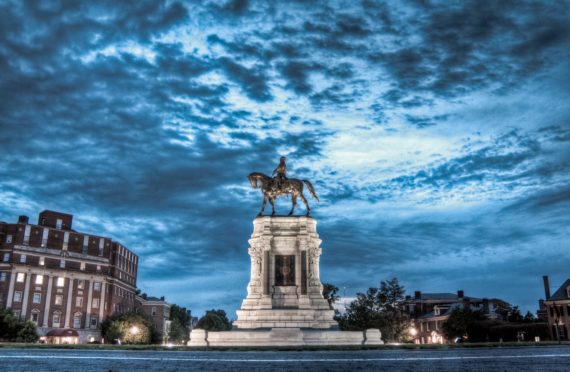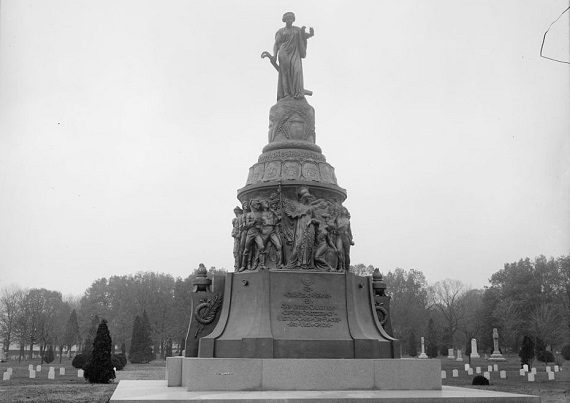I was born and raised in Richmond, Virginia, the capital of the Confederate States of America (CSA) from April 1861 to April 1865. Pictured above is the statue of Confederate Gen. Robert E. Lee on the city’s famous Monument Avenue.
The grand cobblestone street is also adorned with statues of generals J.E.B. Stuart and Thomas “Stonewall” Jackson, and Confederate president Jefferson Davis. But Richmond isn’t a blip in antebellum history or a relic of “Lost Cause” mythology; hers is a rich, complex, and illustrious history from the earliest days. One we should know and study. Not shun or shame.
Under the guidance of Captain Christopher Newport, New World colonialists traveled to Richmond from Jamestown, living and settling among the Powhatan in the 1600s. It was the home of Pocahontas and one of America’s earliest successful white-European communities.
It was in Richmond’s St. John’s Church that Patrick Henry gave his “Give me liberty, or give me death!” speech. It was here, in the heart of the Old Dominion, that Thomas Jefferson passed his Virginia Statute for Religious Freedom. Famous past residents include Chief Justice John Marshal, poet Edgar Allan Poe, and tennis great Arthur Ashe.
Virginia’s Capitol was designed by Jefferson, making Richmond home to the oldest legislature continuously operating in the Western Hemisphere. And it was in this very building that on April 23, 1862, Robert E. Lee stood when he accepted command of the military forces of his beloved Virginia during the “Civil War.”
Like so many native Richmonders and Southerners beyond the shores of the mighty James River, we call this bloody conflict that took the lives of an estimated 700,000 people anything but “civil.” In fact, the true definition of “civil war” is “a war between citizens of the same country.”
Yet, the South had already seceded before war broke out. By doing so, those states set up their own independent confederation – an alliance comprised of 11 strong sovereigns guided by the principles of a newly written Confederate Constitution.
This more-Jeffersonian coalition of subsidiarity also included amicable treaties with the Cherokee, Creek, Choctaw, Chickasaw, and Seminole Indians. The CSA was about bucking central authority, increasing autonomy, and letting each state chart out its own path.
That’s why Dixie chicks like me call the struggle the War for Southern Independence, hearkening back to its similarity of the American colonies’ secession from Britain. Some firebrands, of which the South proudly is in no short supply, even refer to it as the War of Northern Aggression.
Interestingly, Mr. Lincoln never recognized the CSA as a legitimate government. Thus, in his eyes, that would have made North and South part of the same country. So why then didn’t he get the approval of each of the governors and/or their state legislatures before sending in the U.S. military to quell “the rebellion”? That would’ve been the constitutional, legal, and moral thing to do.
Of course, because the war wasn’t about saving the Union or freeing the slaves or promoting the will of the people. It was about economics, resources, power, and revenge – always the real causes for all good protectionist wars, don’t ya know? It was an invasion of a foreign entity, not a civil war amongst fellow countrymen.
Surprisingly, during my time in Richmond’s public schools in the 1970s and 1980s, students were taught the unvarnished history of this pivotal period. Quite amazing considering the 100-plus-year Reconstruction revisionism that had been seeping its way into textbooks and curriculum a la Northern publishers and educrats.
Back then, I was encouraged to study the South, her people and their rightful places in the story of America (and the world) through the lens of history, not modernity and all of its misperceived perfections and moralisms. It’s called context, y’all.
In fact, I attended Douglas Southall Freeman High School, an institution named after the Pulitzer-Prize winning author, who won the honor in 1935 for his four-volume biography on Robert E. Lee. Our yearbook was called “The Historian” in Freeman’s honor.
Our team mascot was the Rebels, whose symbol was a gray-uniformed soldier holding a gun in one hand and a Confederate Battle Flag in the other. The marching band played “Dixie” at football games, as boosters donned Rebel Man pendants and fans waved the Battle Flag.
Today, the school remains DSF and its teams are still the Rebels, but gone are the pre-political-correctness images of a gun-toting Confederate hero. Screw history, even if you’re an institution named after a famous historian: all must bow down to the gods of progressivism and sacrifice nuance, objectivity, and truth on the altar of sensitivity to the uninformed, miseducated, and/or malicious. Just pay your penance and move on, say the useful idiots to we backwards-ass crackers.
Actually, the Cultural Marxists are smart enough to have initially taken aim on 1861-1865. They are a duplicitous bunch, and started small by challenging school mascots and Boy Scouts troop names. Get the low-hanging fruit before you tear the whole tree out by its roots, Jefferson, Washington, Madison and all. They were just a bunch of rich white slave-owners after all. Nothing to be learned here, people. Move along.
Having knocked down the first dominoes, progressives have become increasingly emboldened in their anti-Southern efforts. It may start with Ole Miss banning “Dixie;” Georgia changing its state flag’s 1956-2001 design to be without the Battle flag; the University of Texas removing its Jefferson Davis memorial statue; and South Carolina removing the flag from state grounds. (Have I ever expressed just how much I disdain turncoat Nikki Haley? Ugh.)
Next thing you know, Washington and Lee University has removed its flag display that adorns the Lee monument in Lee Chapel, under which the Confederate general is buried; Charlottesville city council has voted to remove a Lee statue and rename Lee Park; the Southern Baptist Convention has banned the flag (why don’t they just get rid of the word “Southern” while they’re at it?); the National Cathedral has removed flags from its stained-glass windows; and New Orleans is this very day in the throes of a violent cultural clash over removing four monuments, only one of which has actually come down.
Now, as a libertarian, I don’t even believe in public property, which is where these statues are/were erected, nor do I believe in tax-payer-funded schooling, like these ahistorical institutions of “higher learning.” (See, if everything was held in private, this nonsense wouldn’t even be an issue. When “everybody” owns a space, nobody really owns it, right? An argument for another day perhaps.) But a Richmond rebel girl’s gotta take a stand.
Interesting, too, that one of the rationalizations heard from leftist municipal leaders, anti-Southern zealots, and miseducated tyrants is that the monuments and flags must be moved to a museum, you know, put in their “proper place.” You racists can display your “symbols of hate” or whistle “Dixie” at home in private, away from the eyes, ears, and closed minds of totalitarians. Protect the public sphere, they say. It’s for the children. It’s for unity. Gag.
Man, what a carpet-bagger con. What the Cultural Marxists really desire is fully remaking the South in their own image – a progressive product void of all of its unique Southernness, a valuable resource forced to become a mirror image of their disillusioned puritanical paradise. Don’t be fooled by this social-justice scam.
Leftists, of course, possess all the post-modern tools needed to engage in this war of expunging Southern heritage and antiquity: the mainstream-media cabal, the white-guilt-ridden American church, the indoctrination centers of K-12, the university re-education camps, the entertainment biz, and statism – an institution that is always happy to do the bidding of totalitarians who want to force their ideas on the masses.
Because of the influence and power of these apparatchiks, they come, they see, and they eventually conquer, and then they ratchet it up. This is always the modus operandi of progressivism, so the cultural home-wreckers will never cease in their efforts to knock down the whole domino set … but that’s only if no one gives voice to the voiceless: the Southern tradition.
I, for one, will fight against this ongoing Reconstruction of the South. She is a cause worth fighting for. It’s time for all you good Southerners to reject this destruction of her important history and her symbols. Embrace your heritage of stubbornness, anti-authoritarianism, hard-working grit, and self-determination. It’s in your blood.
Be that rebel you were born to be. Be the real resistance. Be bully proof. And just as our Confederate ancestors did, defend your home. It’s time to push back against this cultural genocide of Dixie.







